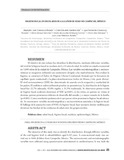Higiene bucal en escolares de 6 a13 años de edad de Campeche, México

Data
2010-04-26Autor
Palabras Clave
Salud bucal, Higiene bucal, Escolares, Epidemiología, MéxicoOral health, Oral hygiene, Schoolchildren, Epidemiology
Metadatos
Mostrar registro completoResumo
El objetivo de este trabajo fue identificar la distribución, mediante diferentes variables, del nivel de la higiene bucal en escolares de 6 a 13 años de edad. Se realizó un estudio transversal en 1.644 niños de la ciudad de Campeche, México. Las variables sociodemográficas y socioeconómicas se recogieron utilizando un cuestionario dirigido a las madres/tutores. Para evaluar la higiene, se construyó el Índice de Higiene Clínico-Conductual, formado por la frecuencia de cepillado (parte conductual) y la placa dentobacteriana (índice de Silness y Löe, parte clínica). El nivel socioeconómico (NSE) fue determinado de acuerdo con la ocupación y escolaridad de los padres. El análisis se realizó utilizando pruebas no paramétricas. La distribución de la higiene bucal fue: 22,7% adecuada, 45,8% regular, y 31,5% inadecuada. Se observaron peores niveles de higiene bucal conforme disminuye el NSE (p<0.01), en los niños, en quienes no visitan al dentista, quienes presentaron defectos de desarrollo del esmalte, y a mayor tamaño de la familia (p<0.001). Como conclusión podemos decir que pocos niños presentaron higiene bucal adecuada. Se encontraron variables sociodemográficas y socioeconómicas asociadas a la higiene bucal. El hallazgo de la asociación entre el NSE y la higiene bucal, hace necesario diseñar medidas para disminuir las brechas de las conductas de salud entre los grupos sociales.
Información Adicional
| Otros Títulos | Oral hygiene in 6-13 year old schoolchildren from Campeche, México |
| ISSN | 1856-3201 |
| Resumen en otro Idioma | The objective of this study was to identify the distribution, through different variables, of the oral hygiene level in schoolchildren aged 6-13 years. A cross-sectional study was carried out in 1644 children from Campeche, Mexico. The socioeconomic and sociodemographic variables were collected using questionnaires administered to mothers/tutors. It was built the Clinical-behavioural Scoring System for oral hygiene, conformed by toothbrushing frequency (behavioural aspect) and dental plaque (Silness and Löe index, clinical aspect), to evaluate the oral hygiene in an ordinal scale as adequate, regular and inadequate. The socioeconomic status (SES) was determined according to the occupation and schooling of parents. Statistical analysis was performed using non-parametric test. The distribution of oral hygiene was: 22.7% adequate, 45.8% regular and 31.5% inadequate. It was observed that when the SES increase, diminish the percentage of inadequate hygiene (p<0.01). The subjects that realized at least one dental visit in the year previous to study have higher percentage of adequate hygiene (p<0.001). When the number of enamel defects and the family size increases, it were observed poorest level of oral hygiene (p<0.001). As conclusion, a low prevalence of adequate oral hygiene was observed, and the relation found between sociodemographic and socioeconomic variables and oral hygiene, make necessary the adoption of measures to reduce the health behaviour gaps between social groups. |
| Colación | 21-30 |
| Sección | Revista Odontológica de Los Andes: Trabajos de Investigación |





